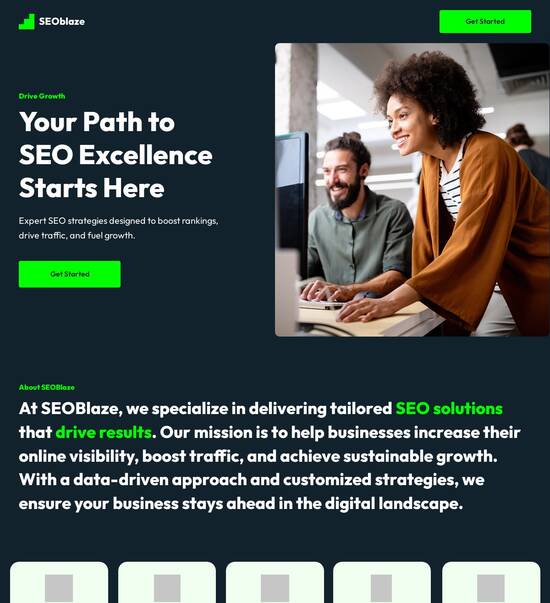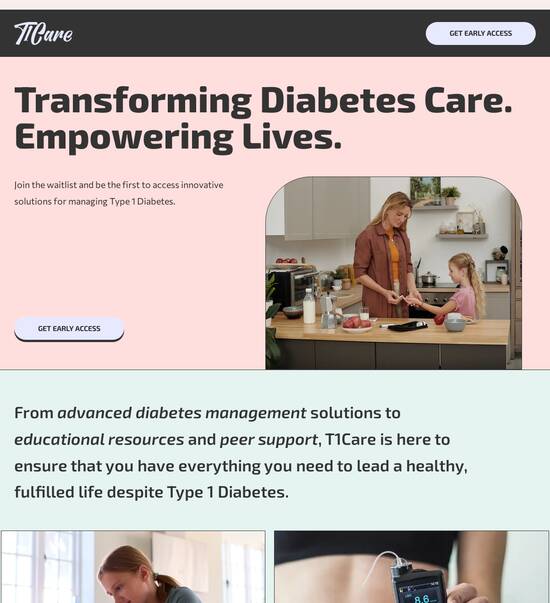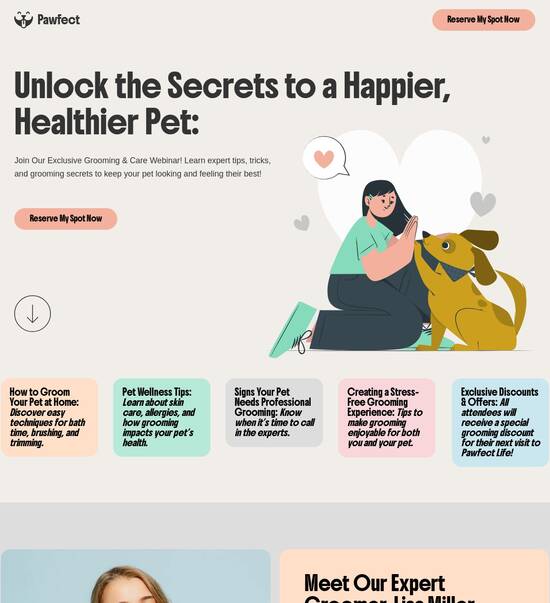
React.js optimized wishlist page template
Explore Similar TemplatesAbout template
Supercharge your wishlist page with React.js for outstanding performance! Learn more today.
Recommended templates

Easy to build without coding
With the intuitive drag-and-drop builder, anyone on your team can create high-converting pages without any knowledge of code or design. Make enhancements to your landing page with custom widgets using Javascript, HTML/CSS, or third-party scripts.

Multiple layouts for any industry and goal
Select from 500+ landing page layouts built to boost conversions across industry-specific scenarios. Customize them by adjusting fonts, adding images, and generating on-brand content with the AI assistant. Quickly scale with Instablocks® and Global Blocks that you can save, reuse, and update globally.

Loads fast and looks polished on any device
Every template is responsive, which means they present professionally on any device and load blazingly fast with our Thor Render Engine. You can also power them up with Google AMP technology to deliver an unparalleled mobile experience and drive higher conversions.

Robust analytics & experimentation
Get real-time updates and reporting across all your devices, showing the number of visitors, conversions, cost-per-visitor, and cost-per-lead. Launch AI-powered experiments, run A/B tests, and use heatmaps to analyze user behavior, then optimize your landing page to maximize conversions.







Easy to build without coding
With the intuitive drag-and-drop builder, anyone on your team can create high-converting pages without any knowledge of code or design. Make enhancements to your landing page with custom widgets using Javascript, HTML/CSS, or third-party scripts.
Multiple layouts for any industry and goal
Select from 500+ landing page layouts built to boost conversions across industry-specific scenarios. Customize them by adjusting fonts, adding images, and generating on-brand content with the AI assistant. Quickly scale with Instablocks® and Global Blocks that you can save, reuse, and update globally.
Loads fast and looks polished on any device
Every template is responsive, which means they present professionally on any device and load blazingly fast with our Thor Render Engine.
Robust analytics & experimentation
Get real-time updates and reporting across all your devices, showing the number of visitors, conversions, cost-per-visitor, and cost-per-lead. Launch AI-powered experiments, run A/B tests, and use heatmaps to analyze user behavior, then optimize your landing page to maximize conversions.
All the features you need to build react node js interview questions
Explore more featuresLearn how to build javascript and react interview questions
Frequently asked questions about react js questions and answers
Leading the way in building high-performing landing pages





React js and javascript interview questions: Your ultimate how-to guide
Instapage stands out as an all-in-one landing page and conversion rate optimization (CRO) platform, enabling marketers to efficiently create, optimize, and scale their digital marketing campaigns. With its comprehensive suite of features, users can expect to maximize their return on investment (ROI) regardless of their team size or budget. Utilizing Instapage, you can access over 100 high-converting templates that significantly accelerate the landing page creation process.
Understanding Instapage's Templates
With more than 100 customizable templates, Instapage gives you a wide array of high-converting options tailored for various industries such as marketing, business services, and financial services. Each template is designed to capture leads effectively, allowing marketers to launch pages swiftly without the cumbersome task of starting from scratch. This saves both time and effort, enhancing campaign efficiency.
- Diverse customization options allow for tailored communication that resonates with specific target audiences.
- Pre-built lead generation elements optimize forms and CTAs to capture more leads.
- Intuitive drag-and-drop builders enable real-time edits, ensuring pages are not only visually appealing but also functional.
Optimizing Your Landing Pages
Optimization plays a critical role in enhancing the effectiveness of any landing page. Instapage empowers users with built-in experimentation features that help fine-tune pages post-launch.
- Heatmapping tools allow you to visualize user engagement on your page, helping identify key interest areas.
- A/B testing capabilities enable you to test multiple elements of your landing pages for optimal performance.
- An analytics dashboard provides detailed insights into user behavior and conversion metrics, making it easy to adjust strategy accordingly.
Personalization for Enhanced Engagement
Personalization is key to delivering relevant user experiences. With Instapage, dynamic text replacement ensures your messages resonate with varied audiences, while AdMaps help align advertising efforts with dedicated landing pages.
- Dynamically generated content can cater to specific user preferences, enhancing engagement rates.
- The use of audience-specific metrics allows for precise targeting and continually refined marketing approaches.
- Integrating personalized experiences ultimately leads to higher conversion rates and improved ROIs.
Leveraging collaboration tools allows teams to enhance productivity. Instant feedback loops and real-time editing capabilities streamline the page creation process, making it easy to incorporate stakeholder insights.
In conclusion, utilizing Instapage transforms how marketers approach landing pages and CRO initiatives, ensuring that campaigns are not only effective but also scalable.
Don’t wait to supercharge your digital marketing efforts. Explore how Instapage can streamline your landing page creation, optimize conversions, and significantly enhance ROI.
People also ask about react js components
Crafting the Ideal ReactJS Optimized Wishlist Page Template
The power of wishlist functionality in e-commerce
Wishlists are transforming the landscape of online shopping by providing users with a personalized, organized way to keep track of desired products. This functionality plays a crucial role in modern e-commerce, guiding users through their journey from consideration to purchase. Not only do wishlists enhance the shopping experience, but they also serve as a pivotal touchpoint for capturing potential sales that might otherwise slip through the cracks.
By enabling users to curate lists of favorite items, wishlists significantly enhance user engagement. Shoppers return to platforms that allow them to save items for later, which in turn boosts conversion rates. Particularly during seasonal shopping periods, the ability to create and share wishlists can lead to increased traffic as users refer friends and family, thereby broadening market reach.
Fashion and Apparel: Allowing customers to save outfits or accessories they wish to purchase.
Home Decor: Helping users keep track of items for future purchases to enhance their living space.
Gifts: Facilitating easy selections for holidays or special occasions through shared lists.
Responsive design: ensuring accessibility across devices
With the rise of mobile shopping, optimizing the wishlist page for various devices is no longer optional; it's a necessity. Accessibility across devices not only makes the user experience smoother but also increases the likelihood of users returning to complete their purchases. Mobile optimization should ensure that all functionalities of the wishlist are easily accessible on small screens.
ReactJS simplifies the process of creating responsive designs through features like CSS modules and paired libraries such as React Responsive. Developers can implement breakpoints and media queries tailored specifically for wishlists, ensuring each element responds dynamically regardless of the device used. By prioritizing mobile users, businesses can significantly enhance user satisfaction and drive conversions.
Design with flexible grids to adapt to various screens.
Utilize scaling fonts and buttons for easier interaction.
Test across devices to ensure uniform functionality.
Leveraging ReactJS technologies for performance boosts
ReactJS offers several built-in technologies that can significantly enhance the performance of a wishlist page. One key feature is the virtual DOM, which improves rendering efficiency by only updating components that change, rather than reloading the entire UI. This leads to a quicker and more responsive user experience, critical in maintaining user engagement.
Additionally, implementing code splitting can drastically reduce initial load times for wishlist components. By loading only the necessary components when needed, businesses can ensure that users do not face long wait times. Lazy loading for images and resources allows for media to be loaded only as users scroll, further optimizing performance while enhancing the viewing experience.
Community insights: best practices from experienced developers
Engaging with the ReactJS community is invaluable for developers looking to enhance their wishlist pages. Various forums like Stack Overflow and Reddit serve as hubs where developers share their experiences, challenges, and solutions. By analyzing successful wishlist templates shared by other users, developers can incorporate best practices and features that resonate well in real-world applications.
Moreover, participating in open-source collectives empowers developers to contribute to existing projects, learning valuable lessons along the way. This collaboration fosters an ecosystem where innovative ideas around wishlist functionalities can flourish, helping everyone stay updated with the latest trends and methodologies.
Building a seamless user experience with advanced features
When constructing a wishlist page, incorporating essential features is crucial for creating an enjoyable user experience. User authentication allows customers to maintain personalized accessibility, making it easier for them to keep track of items across devices. Moreover, enabling users to easily add or remove products from their wishlist enriches the experience, allowing them to adapt their preferences effortlessly.
Real-time updates can take the user experience to the next level, primarily through technologies like WebSocket connections. Implementing instant notifications about changes, such as price drops or item availability, can create a sense of urgency, encouraging users to take action on their wishlist items sooner rather than later.
Exploring various regions: tailoring wishlist templates to local preferences
Understanding the local market is essential when designing wishlist templates. Analyzing geographic preferences can help tailor features that cater nicely to different cultures. For example, gift-giving traditions vary widely, and a wishlist design that considers these differences can attract more users in specific regions.
Cultural considerations should extend beyond aesthetics; it also involves functionality, such as payment methods and notifications. Furthermore, language localization techniques are important for ensuring that users can navigate and engage with the wishlist page comfortably, regardless of their native language. Catering to regional preferences broadens market opportunities and demonstrates cultural sensitivity.
Formulating effective content strategies for engagement
An enticing call to action within the wishlist page can inspire users to explore more products or complete their purchases. Clever prompts highlighting special offers or encouraging users to view trending items can draw more attention to important product categories relevant to their preferences.
Furthermore, incorporating user-generated content significantly enhances trust. Showcasing top wishlist products through customer testimonials can validate choices and influence potential buyers. Displaying positive user reviews alongside wishlist items enriches the purchasing experience, fostering a community-oriented approach.
Addressing common community questions and challenges
Developers often encounter specific challenges while implementing wishlist functionalities in ReactJS. Common FAQs typically revolve around data persistence, accessibility settings, and integration with existing e-commerce platforms. Establishing a clear approach to each of these issues ensures that developers feel supported throughout the process.
Additionally, troubleshooting common issues is paramount for facilitating a smoother implementation journey. Maintaining documentation about common pitfalls, along with corresponding solutions, can empower developers to address challenges quickly and effectively, thus reducing development time and boosting confidence in the project.
Team collaboration in developing the wishlist page
The development of a wishlist page is never a solo endeavor; it benefits greatly from the collaborative efforts of cross-functional teams. A strong synergy among designers, developers, and product managers can lead to a more refined and effective final product. Regularly scheduled touchpoints foster an environment where ideas flow freely, resulting in innovative solutions to complex problems.
Implementing agile methodologies promotes iterative improvements, allowing teams to react quickly to feedback. Utilizing tools like Trello or Jira can help manage tasks and document processes. Facilitating teamwork is essential for ensuring that the wishlist page meets user needs while adhering to project timelines.
Feature comparisons: ReactJS versus other frameworks
When considering framework choices for developing a wishlist page, ReactJS stands out due to its flexibility and robust performance capabilities. Unlike some other frameworks, React's capitalizes on the virtual DOM to minimize rendering times, providing a smoother user experience. Additionally, the extensive library of supporting tools and community resources amplifies React’s appeal.
Case studies of successful implementations across various frameworks, such as Angular or Vue.js, reveal that while they may offer unique strengths; React consistently excels when it comes to scalability. Evaluating past projects can provide insights into how ReactJS's features optimize overall wishlist functionalities compared to alternative options.
Future-forward wishlist features: predicting market trends
Anticipating future trends in wishlist functionalities is critical for remaining competitive. Emerging technologies like artificial intelligence (AI) can personalize user experiences, utilizing data analysis to predict items users are likely to add to their wishlist. This level of customization could significantly impact user satisfaction and ultimately drive more conversions.
Moreover, exploring augmented reality (AR) and virtual reality (VR) presents exciting opportunities for creating immersive shopping experiences. While still evolving, these technologies can allow users to visualize products in realistic settings, enhancing decision-making and increasing the likelihood of wishlist items being purchased.
Capturing feedback: the importance of user interaction
User interaction plays a pivotal role in refining wishlist functionalities. Implementing mechanisms to capture user feedback, such as surveys or feedback buttons, offers direct insights into their preferences and experiences. Analyzing user behavior through tools like heatmaps or session recordings can provide a wealth of information about how individuals engage with the wishlist page.
Leveraging these insights allows teams to evolve the wishlist continuously, adapting features and functionalities based on real user data. Creating a feedback loop ensures that improvements are grounded in genuine user experiences, making for a more responsive and successful product overall.
Fine-tuning with analytics: measuring success
To gauge the effectiveness of wishlist functionalities, it’s essential to identify key performance indicators (KPIs). Metrics such as the number of items added to wishlists, conversion rates from wishlists, and user retention after wishlist interactions can provide a comprehensive overview of performance. Monitoring these KPIs helps in recognizing patterns in user engagement and informs data-driven decisions.
Tools like Google Analytics or Mixpanel can facilitate tracking and analyzing wishlist page performance. Adapting strategies based on insights derived from this data not only enhances user experience but also boosts overall conversion rates. By ensuring alignment between user needs and business goals, organizations can achieve sustainable growth through effective wishlist functionalities.
Inquiry and knowledge sharing: building a resourceful network
Establishing platforms for ongoing Q&A among developers encourages a culture of knowledge sharing. Participating in community forums or creating dedicated Slack channels can facilitate discussions around wishlist functionalities and help individuals navigate challenges more effectively. A collective resource base that includes tutorials, guides, and documentation can assist developers in maximizing their ReactJS efforts.
Encouraging open dialogue about experiences and problem-solving strategies fosters a supportive environment, paving the way for innovative feature enhancements. This communal growth mindset can lead to significant advancements in wishlist technology, benefiting future projects and the wider developer community.
Ready to skyrocket conversions?
Supercharge your ad campaigns with high-performing landing pages
Get started














